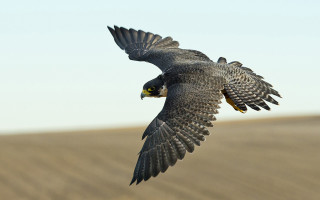Birds on the battlefield: Research into "living network nodes" for contested zones
StoryJune 16, 2020

Trained animals – including birds of prey and even dogs – may play a role in helping military forces manage mobile networks on the battlefield and in risky areas, according to a team of researchers at the U.S. Navy’s Naval Postgraduate School (NPS – Monterey, California).
Alex Bordetsky, professor of information sciences at the U.S. Navy’s Naval Postgraduate School (NPS) and director of the school’s Center for Network Innovation and Experimentation (CENETIX), has recently focused on what he calls “networks with short living nodes and links … I named it ‘networks that don’t exist’ – meaning that that they don’t exist for noticeable period(s) of time or within well-defined areas of space … so they move quickly, from one place to another, and then their setting changes.”
Short-lived networks could be useful on the battlefield: A roving location for a network connection, a quick volley of information, then the network vanishes before an adversary can intercept information. Aside from being less noticeable than machine nodes, biological nodes including birds (like falcons) or dogs would not be affected by tracking, GPS jamming, or other deliberate disruptions.
The CENETIX team, with longstanding support from the NPS Consortium for Robotics and Unmanned Systems Education and Research (CRUSER), has steered its research in some unconventional directions: Over the past two years, this research road less traveled has included development and testing of nodes that produce short, what it calls “burst-y” communications in mesh networks.
Bordetsky says that such transient nodes are potentially valuable parts of a system that is “specifically suitable for contested environments in which cyber physical clutter is predominant,” for example if both friendly and hostile forces are communicating over multiple channels in a small area or when one of the sides is underwater.
“In modern warfare you have nothing if you do not have network,” says Eugene Bourakov, senior researcher and chief engineer for the CENETIX team: Increased network-node range and discreteness is a must to maintain the advantage.
Army Special Forces Majs. Brandon Davis and Garrett Whittaker previously examined the usefulness of mesh networks in integrating counter-drone, or counter-unmanned aerial system (UAS) sensors in Android tactical assault kits (ATAKs), a smartphone app used in the field for geospatial infrastructure and military situational awareness. The pair discovered that self-contained mesh networks enabled local ATAKs to talk to each other without using the internet, which opposition forces could detect and intercept.
For this newer mobile-node project, Whittaker explains, “What we’re doing is we’re taking the server – which was historically run on like a large pipe internet from a cloud-based server – and putting it on a standalone laptop that’s not connected to the internet and running that server across this much lower bandwidth.”
The research comes, say Navy officials, as the U.S Department of Defense (DoD) sets itself up to counter future adversaries who will use electronic signatures to detect, locate, and target U.S. troops on the battlefield.
The idea for incorporating birds of prey as mobile relays to enable moveable tactical networks combines several research threads at NPS, with an additional approach stemming from civilian falconry, Marine Corps Maj. Joshua Freedman reported during a previous conference held at NPS in 2018. One of those research endeavors investigated the use of a modified grenade launcher to fire a network device into the air, where it hung from a small parachute and relayed bursts of data to ground nodes. Freedman and a colleague Maj. Justin Murphy took the concept of using falcons for a similar function from research into the use of trained birds to detect and take down small drones, plus the trend of falconers strapping tiny video cameras to their birds, Freedman said.
The researchers also suggested dogs could be used for short-lived mobile ground-based network hubs.
The CENETIX team now intends to take its fast-moving node thesis to space: In a launch intended for June 2020, the researchers – working with the U.S. Marine Corps Warfighting Lab, Mechatronics, and UAS company AeroVironment, and in collaboration with NPS Space Systems Academic Group (SSAG) – will send a CubeSat payload into low orbit in a test of multidomain mesh networking capabilities with fast-moving nodes in space.









